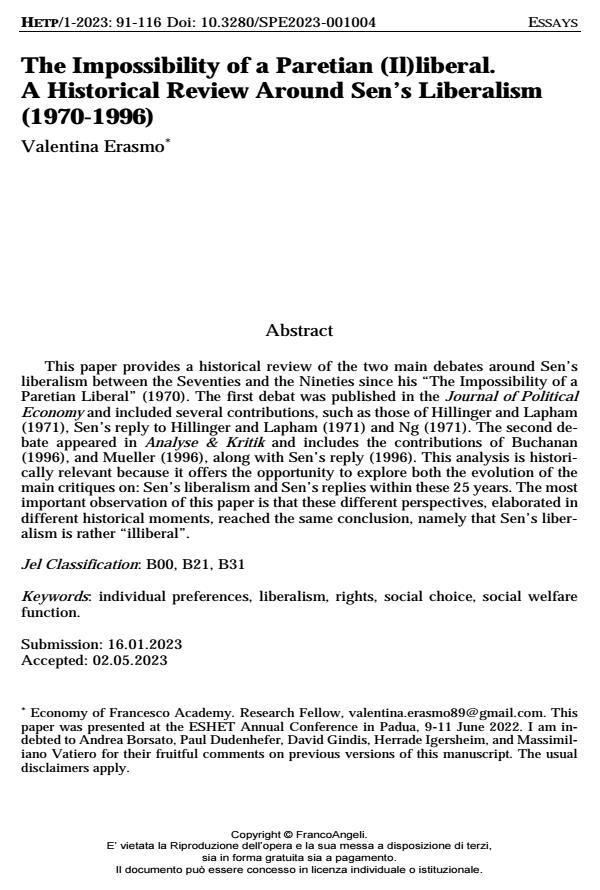The Impossibility of a Paretian (Il)liberal. A Historical Review Around Sen’s Liberalism (1970-1996)
Titolo Rivista HISTORY OF ECONOMIC THOUGHT AND POLICY
Autori/Curatori Valentina Erasmo
Anno di pubblicazione 2023 Fascicolo 2023/1
Lingua Inglese Numero pagine 26 P. 91-116 Dimensione file 176 KB
DOI 10.3280/SPE2023-001004
Il DOI è il codice a barre della proprietà intellettuale: per saperne di più
clicca qui
Qui sotto puoi vedere in anteprima la prima pagina di questo articolo.
Se questo articolo ti interessa, lo puoi acquistare (e scaricare in formato pdf) seguendo le facili indicazioni per acquistare il download credit. Acquista Download Credits per scaricare questo Articolo in formato PDF

FrancoAngeli è membro della Publishers International Linking Association, Inc (PILA)associazione indipendente e non profit per facilitare (attraverso i servizi tecnologici implementati da CrossRef.org) l’accesso degli studiosi ai contenuti digitali nelle pubblicazioni professionali e scientifiche
This paper provides a historical review of the two main debates around Sen’s liberalism between the Seventies and the Nineties since his "The Impossibility of a Paretian Liberal2 (1970). The first debat was published in the Journal of Political Economy and included several contributions, such as those of Hillinger and Lapham (1971), Sen’s reply to Hillinger and Lapham (1971) and Ng (1971). The second de- bate appeared in Analyse & Kritik and includes the contributions of Buchanan (1996), and Mueller (1996), along with Sen’s reply (1996). This analysis is histori- cally relevant because it offers the opportunity to explore both the evolution of the main critiques on: Sen’s liberalism and Sen’s replies within these 25 years. The most important observation of this paper is that these different perspectives, elaborated in different historical moments, reached the same conclusion, namely that Sen’s liber- alism is rather "illiberal".
Parole chiave:individual preferences, liberalism, rights, social choice, social welfare function.
Jel codes:B00, B21, B31
- ‘Who are the capability theorists?’: a tale of the origins and development of the capability approach Valentina Erasmo, in Cambridge Journal of Economics /2024 pp.425
DOI: 10.1093/cje/beae004 - What should a liberal economist (not) do? Sen–Sugden debate on welfare economics Valentina Erasmo, Paolo Santori, in Cambridge Journal of Economics /2025 pp.849
DOI: 10.1093/cje/beaf023
Valentina Erasmo, The Impossibility of a Paretian (Il)liberal. A Historical Review Around Sen’s Liberalism (1970-1996) in "HISTORY OF ECONOMIC THOUGHT AND POLICY" 1/2023, pp 91-116, DOI: 10.3280/SPE2023-001004